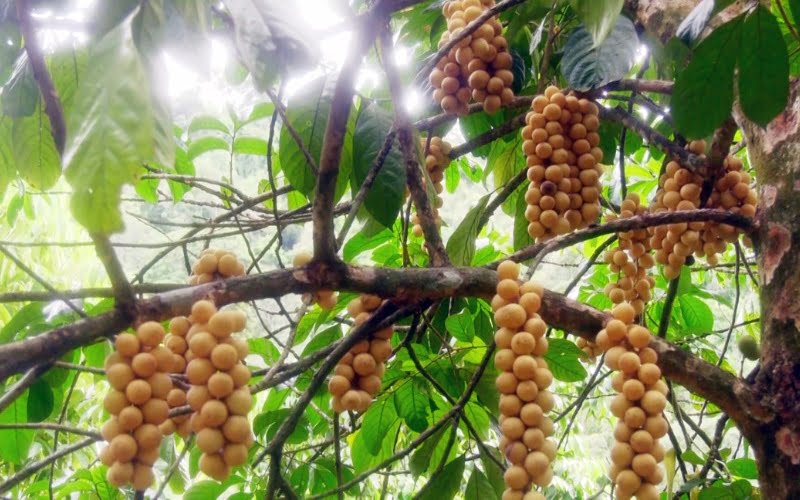
Bon Bon Vietnamese Fruit: All You Need to Know
We will bring you useful information about Bon Bon Vietnamese fruit
This article delves into the world of Bon Bon fruit, exploring its historical roots, its unique flavor, and the best ways to enjoy it. Learn how to select ripe, chemical-free Bon Bon, tips for storage, and delectable recipes like Bon Bon fruit salad. Join us in uncovering the exceptional taste of Bon Bon, a true tropical treasure from Vietnam.
What is Bon Bon Vietnamese fruit?

The Bon Bon Vietnamese fruit, known as ‘bòn bon’ and in some regions as ‘lòn bon,’ is a tropical fruit. The tree typically reaches a height of 10-15 meters, and the fruit itself is round with a diameter ranging from 3-5 cm.

A Bon Bon tree in Tien Phuoc, Quang Nam, Vietnam. Photo by Le Trung/tuoitre.vn
Bon Bon fruits grow in clusters, usually with 20 to 40 fruits per cluster. When they ripen, the skin of the Bon Bon fruit turns a light brown color. When you peel the skin of the Bon Bon fruit, you’ll find 5-6 translucent white segments inside. In each segment, there is one seed.
The Bon Bon fruit, scientifically known as Lansium domesticum, is also referred to as langsat or lanzones in English. It belongs to the Meliaceae family. The species is native to Southeast Asia.
Bon Bon fruits are usually picked during September and October annually. They tend to crack when exposed to heavy rain or intense sunlight.

Picking Bon Bon fruits in Tien Phuoc, Quang Nam, Vietnam. Photo by Le Trung/tuoitre.vn
In Vietnam, where are Bon Bon fruits primarily grown?

The Bon Bon tree is mainly grown in mountainous areas and the midlands of Quang Nam province, with Tien Phuoc being considered the ‘capital’ of this plant. The Bon Bon fruit from Tien Phuoc is known for its unique flavor and sweetness, and it was historically offered to the king as a special delicacy. Additionally, the tree is also cultivated in the Mekong Delta provinces of Ben Tre, Can Tho, and Hau Giang.

Did you know?
Quang Nam is renowned for the ancient town of Hoi An, a UNESCO World Cultural Heritage site. Meanwhile, Tien Phuoc is a mountainous district in Quang Nam province, located approximately 80km southwest of Hoi An.
Tien Phuoc isn’t just known for its Bon Bon fruit; it’s also the base for startups creating eco-friendly products from areca leaf sheaths.
Tasting the Bon Bon Vietnamese fruit

To enjoy a Bon Bon fruit, you’ll first need to remove its outer skin, as it’s not edible. Once peeled, you need to separate the seeds from the flesh because they are very bitter. The flesh offers a delightful combination of sweetness with subtle sourness, creating a unique and refreshing flavor profile.
The legend of Bon Bon fruit in Vietnam

Image: thanhnien.vn
In the past, Bon Bon fruit was also known by the name “Nam trân”. This name originated from a legend about King Gia Long.
Legend has it that during the Tay Son Rebellion, commonly known as the Vietnamese Civil War from 1771 to 1802, when the Tay Son troops attacked the capital city of Phu Xuan, Lord Nguyen Phuc Anh, pursued by the Tay Son forces, fled into the forests of Dai Loc, Quang Nam. In a state of hunger and thirst, he stumbled upon a wild fruit that helped him endure his hunger. After ascending to the throne and adopting the title Gia Long, he remembered the fruit that had saved him and decided to name it “Nam trân”, which means “the precious fruit of the South” in Vietnamese
The Tay Son rebellion (1771–1802) was a series of military conflicts stemming from the Vietnamese peasant uprising of Tay Son, led by three brothers: Nguyen Nhac, Nguyen Hue, and Nguyen Lu. These conflicts began in 1771 and ended in 1802 when Nguyen Phuc Anh, later known as Emperor Gia Long and a descendant of the Nguyen lords, defeated the Tay Son forces and reunified Dai Viet, subsequently renaming the country Vietnam.
Tips for selecting ripe and chemical-free Bon Bon

Naturally ripened Bon Bon fruit (Image: VITA MARKET)
Vietnamese Fruits: The Best Varieties to Try in Vietnam
We’ve put together the ultimate list of Vietnam’s best fruits just for you. To make it even more fun, take our quiz and see how well you know your Vietnamese fruits. Plus, don’t miss our handy PDF guide packed with all the details about these amazing fruits! [Read]
Tips for storing Bon Bon fruit
Fresh Bon Bon Vietnamese fruit can only be kept at room temperature for a maximum of 4 days. If you want to store them for up to 2 weeks, it’s best to keep them in the refrigerator at 12°C. However, it’s recommended to consume them within about 7 days from the time of harvest for the best flavor.
Tips for eating Bon Bon fruit
The special Bon Bon fruit salad

Image: Thanh Ly/ tuoitre.vn
Ingredients
How to make Bon Bon fruit salad

Image: Thanh Ly/ tuoitre.vn
Introducing wine made from Bon Bon Vietnamese fruit

The Bon Bon wine from Tien Phuoc is the culmination of years of research by farmers in Tien Phuoc, Quang Nam.
Crafted using traditional methods, it undergoes natural fermentation and aging in oak barrels under carefully controlled temperature and humidity conditions to develop its unique flavor and exceptional purity.






Leave a Reply